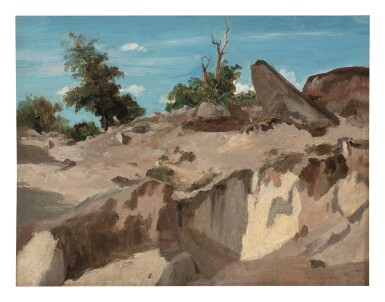
Property from Galerie Sanct Lucas, Vienna
JEAN-BAPTISTE-CAMILLE COROT | FORÊT DE FONTAINEBLEAU - AU PLATEAU BRÛLÉ
Lot Closed
June 25, 03:37 PM GMT
Estimate
70,000 - 90,000 USD
Lot Details
Description
Property from Galerie Sanct Lucas, Vienna
JEAN-BAPTISTE-CAMILLE COROT
Paris 1796 - 1875 Ville d'Avray
FORÊT DE FONTAINEBLEAU - AU PLATEAU BRÛLÉ
oil on paper, laid down on canvas
unframed: 9⅞ by 12⅝ in.; 25 by 32 cm.
framed: 17 x 19 ¾ in.; 43 by 50.3 cm.
Prevost collection;
By whom sold, Paris, Hotel Drouot, 24 May 1887, lot 20 (for 190 francs);
Private collection (The Estate of Madame B);
Anonymous sale, Paris, Binoche Renaud-Giquello & Associés, 29 March 2019, lot 21;
There acquired.
A. Robaut, L’oeuvre de Corot, Catalogue raisonné et illustré, Paris 1965, vol. II, p. 284, cat. no. 893, reproduced.
"Corot has always been one of my favorite artists, and this freely painted landscape of rocks and trees in the forest of Fontainebleau shows him working in plein air style. Corot painted the forest of Fontainebleau throughout his career, and the beautiful light falling on the rocks in the foreground and the vibrant blue sky in the background is everything you could want from a work by the artist."
George Wachter
Jean-Baptiste-Camille Corot was one of the most important landscape painters in 19th century France. His style absorbed that of the 17th century masters Claude Lorrain and Nicolas Poussin and anticipated the Impressionist landscapes of the later 19th century. With his soft and fluid brushwork as well as his remarkable understanding of light, his landscape sketches like the present emit an air of timeless modernity. Imbued with harmonious tones as well as a crisp freshness, this wondrous work illustrates a beautifully observed plateau in the forest of Fontainebleau, about thirty-five miles southeast of Paris. With its verdant foliage, imposing trees, bare plateaus, and notable rock formations, this forest served as an endless source of visual inspiration for Corot throughout his long and successful career. His earliest painted impressions of this location arose after his visit to Fontainebleau with Achille Michallon in the summer of 1822, and he would regularly return over the years with other artists, such as Jean-Victor Bertin and Théodore Caruelle d'Aligny. The forest even served as the subject of a few of his Salon submissions, including that of 1846, today in the Museum of Fine Arts, Boston.1 It was in this forest that Corot first began to experiment with the technique of painting en plein air, a method that allowed him to capture the immediate impression of his natural surroundings, as well as the beauty and emotion these settings imparted. Corot explored and further developed his plein air style on his sojourns through Italy: the first from 1825-1828, the second in 1834 and the third in 1843.
The present painting, titled Forêt de Fontainebleau - Au plateau brûlé, is dated by Robaut to circa 1850-1855 and constitutes one of the most vigorous studies that Corot completed of the forest. Here, his technical concerns and artistic interests are truly palpable. With a confident and rapid brush, he records a realistic impression of the of the geological peculiarities of this plateau, rendering their dense and sunlit forms in a manner that recalls his time in Italy. Just as in Corot's Quarry of Chaise-Marie at Fontainebleau (fig. 1), cracked earth and a pile of rocks fill the composition—their sheer disorder and luminous vitality providing sculptural richness and a monumental harmony to the study. At the same time, the use of pure and direct light as well as his balance of an intense blue sky with the green foliage of the trees and the delicate greys, browns, and ochres for the earth, recalls an impression recorded by Corot in his Oak Trees at Bas-Bréau (fig. 2), an earlier sketch of the forest today in the Metropolitan Museum of Art.
1. https://collections.mfa.org/objects/31016/forest-of-fontainebleau
